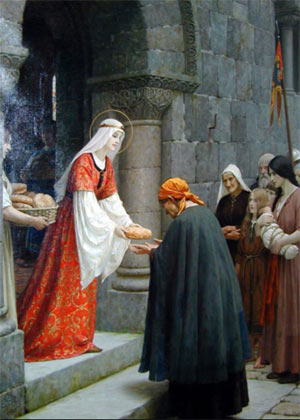Feast of Our Lady of the Miraculous Medal

Domine Jesu Christe, qui beatissimam Virginem Mariam Matrem tuam ab orgine immaculatam innumeris miraculis clarescere voluisti: concede, ut ejusdem patrocinium semper implorentes, gaudia consequamur aeterna. Qui vivis et regnas cum Deo Patre, in unitate Spiritus Sancti, Deus, per omnia saecula saeculorum. Amen.
"O Lord Jesus Christ, who have vouchsafed to glorify by numberless miracles, the Blessed Virgin Mary, immaculate from the first moment of her conception, grant that all who devoutly implore her protection on earth, may eternally enjoy Your presence in heaven, whom with the Father and the Holy Spirit, live and reign, God, for ever and ever. Amen." (not exactly a direct translation, but the one currently in use at Miraculous Medal novenas across the English-speaking world)
Though it is not observed on the "Novus Ordo" calendar, and it was only observed in a few places on the traditional calendar, November 27 is the Feast of Our Lady of the Miraculous Medal. It was on this day in 1830 that Our Lady appeared to St. Catherine Laboure for the second of three times. The design of the Miraculous Medal (which was originally known as the Medal of the Immaculate Conception) was first revealed to her during this apparition. During the apparition, a voice said to her, "Have a medal struck upon this model. All those who wear it, when it is blessed, will receive great graces, especially if they wear it round the neck. Those who repeat this prayer with devotion will be in a special manner under the protection of the Mother of God. Graces will be abundantly bestowed upon those who have confidence."
While only 20,000 medals were made at first, word of the new medal quickly spread across Europe, and then across the world. It became known as the Miraculous Medal "due to the unprecedented number of miracles, conversions, cures, and acts of protection attributed to Our Lady's intercession for those who wore it" (taken from "Mary's Miraculous Medal," published in 1999 by the Slaves of the Immaculate Heart of Mary of Vienna, Ohio).
One of the most famous miracles associated with the medal took place in 1842, when Alphonse Ratisbonne, an agnostic Jew from France, was converted instantly to the Catholic faith, after he wore the Miraculous Medal and said the Memorare twice a day for nine days straight. Our Lady appeared to him in the church of Sant' Andrea delle Frate, and after she departed, he begged his friend to take him to be baptized. (an article about Ratisbonne's conversion can be read at Conversion story of Alphonse Ratisbonne)
St. Maximilian Kolbe, the great saint of the first half of the 20th century, said his first Mass in the church of Sant' Andrea. He was inspired by the miracles associated with the Miraculous Medal, especially that of Ratisbonne. He called the Medal " a 'bullet' with which a faithful soldier hits the enemy, that is evil, and thus rescues souls" (taken from Wear the Miraculous Medal). He encouraged all Catholics to wear the Medal and spread its devotion, even to non-Catholics.
May the Blessed Virgin Mary, the Immaculate Conception, intercede for us always, especially under her title of Our Lady of the Miraculous Medal.
(The above image is taken from Beuron Exhibit 98. It is of the Beuronese style of sacred art, which dates from the late 19th and early 20th centuries. A good article on this style of art can be read at The Art of Beuron (SSPX Angelus magazine article). I recently read an article about the Nazarene painters, who directly inspired the first Beuronese painters in The Latin Mass magazine, which lead me to read more about both groups/styles.)


